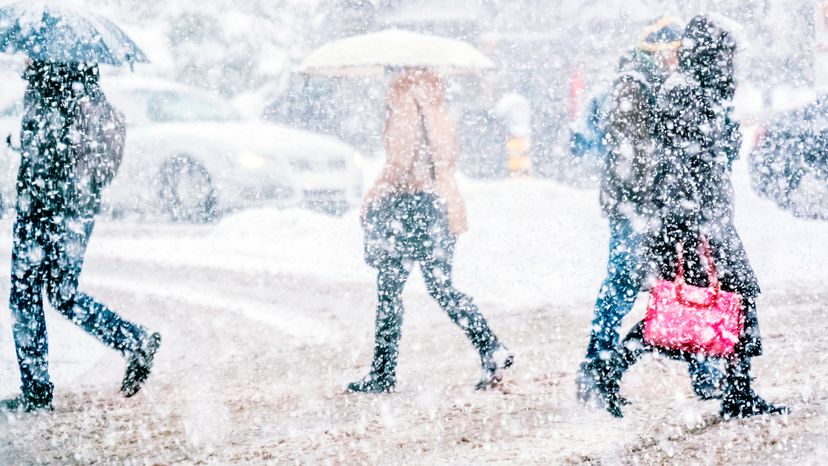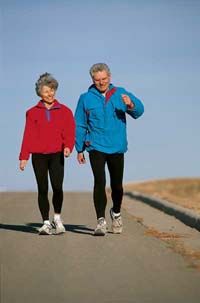No matter how fit you are, you need to be careful of the dangers of walking in the heat -- especially if the humidity is high. Even experienced athletes can fall victim to serious heat-related ailments if they don't take special precautions. You may simply have to stop walking outdoors and move your walking program inside, to an air-conditioned track, gym, or mall.
Your body's built-in cooling system helps it to maintain its normal temperature of approximately 98.6 degrees Fahrenheit when you're in a hot environment. The evaporation of sweat from the surface of your skin causes cooling.
In addition, the blood vessels in your skin dilate (expand) to let more blood flow through them. (That's why your skin gets flushed from a hard workout.) As your blood circulates through the innermost region of your body, known as the body core, it heats up. When it reaches the blood vessels in the skin, the heat radiates outward.
This natural "air-conditioning" system isn't foolproof, however. If you don't replace the water that you lose through sweat, you can become dehydrated. Without adequate water, your sweating mechanism can't work effectively. In the extreme case, this mechanism can shut down completely.
High humidity coupled with warm temperatures can also greatly hamper your body's ability to stay cool. When it's humid, there's already so much moisture in the air that your sweat can't evaporate as quickly. (On the other hand, a breeze can help your body maintain proper temperature by aiding in the evaporation of sweat.) As a result, your body loses water as it pumps out sweat, yet your body temperature continues to rise.
Another important factor in how well your body deals with heat is acclimatization. Your body needs anywhere from four days to two weeks to make physiological adjustments that allow it to cope with extreme heat.
As the body becomes acclimatized, it lowers its threshold for sweating -- in other words, it switches on the sweating mechanism before body temperature rises too high. In addition, it produces more sweat and distributes the sweat more effectively over the skin surface to allow cooling.
The body also directs more blood toward the surface of the skin so that heat from deep within the body core can radiate out of the body. If the body hasn't had time to make these adjustments, however, it may not be able to handle heat effectively.
If you overdo it in the heat, you can develop a series of problems. There are three major types of heat illness: heat cramps, heat exhaustion, and heatstroke. Heat cramps are the least serious and heatstroke is the most threatening. Their symptoms overlap, however, and if proper measures aren't taken at the first sign of heat injury, heat illness can progress to its most severe form.
Heat cramps are painful muscle spasms that occur during or after intense exercise. The spasms usually occur in the muscles that are being exercised and may be caused by the loss of water and salt through sweat. The body temperature is usually not elevated. Rest and replacement of fluids can usually help relieve heat cramps.
Heat exhaustion, also called heat prostration, is a common heat-related illness that occurs most often in people who are not acclimatized to hot weather. It sometimes occurs after excessive perspiration, coupled with inadequate consumption of water to replace lost liquids.
Symptoms of heat exhaustion include weakness; dizziness; collapse; headache; weak, rapid pulse; cold, clammy skin; and dilated pupils. The victim of heat exhaustion usually has a near-normal body temperature and continues to sweat.
If you experience any of these symptoms while walking in hot weather, move to a cool place, rest, and drink plenty of water.
Heatstroke, also called sunstroke, is the most serious heat-related illness and requires immediate medical attention. Heatstroke occurs when the body cannot get rid of heat fast enough. The body's cooling system is overwhelmed and simply breaks down.
Sweating usually stops, the circulatory system is strained, and body temperature can rise to 106 degrees Fahrenheit or more. If immediate steps to cool the victim aren't taken, body temperature will continue to rise and death may occur.
Symptoms of heatstroke include hot, dry skin; rapid pulse; high body temperature; headache; dizziness; abdominal cramps; and delirium. Often, however, the first visible sign of heatstroke is loss of consciousness.
Immediate steps must be taken to decrease the victim's body temperature. The victim should be moved to a cool area and placed in an ice-water bath or covered with ice packs until medical treatment is available.
Go to the next section to find out how you can protect yourself in the heat during a walk.
To learn more about walking, see:


